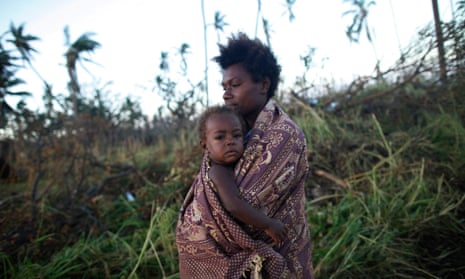More than four months after Cyclone Pam, one of the most powerful ever recorded in the south Pacific, emergency aid is winding down in the Vanuatu archipelago, leaving inhabitants of rural islands facing an uncertain future. Tanna, an island 200km south of the capital Port-Vila, took a direct hit on 13 March. The wreckage is still visible: the tops of banyan trees have been lopped off, roofs ripped away and churches flattened. Trees on island were stripped by winds gusting at over 320km/h, but now fresh greenery is bursting out and people are rebuilding their homes and replanting their fields.
“We’ve sawn up timber from banyan and avocado trees to make beams, cut bamboo for the walls and dried coconut leaves for the roof. Once we’ve gathered up all the materials in the forest, it takes a fortnight to actually build a house; everyone here knows how to do that,” says David, from Port Resolution on the east coast.
The flexible structure of the traditional huts explains why the death toll was relatively low – only 16 storm-related fatalities – despite the severity of the cyclone. In rural areas the traditional housing model also makes reconstruction quicker and cheaper. “Actually the worst part is not the house, but the garden,” David adds.
On Tanna almost all households depend on the crops they grow for their own use. Most of them were seriously damaged. Only a few sweet yams were saved, Pam having arrived just after the harvest.
These meagre reserves are now being supplemented by the first vegetables grown from seed distributed as part of emergency aid. But it will be some time before Vanuatu staples are again available. “It takes three months for sweet potatoes to grow, nine months for taro roots and leaves, a year for bananas ... In the meantime, we’ll scrape by,” David says with a shrug.
With Tanna still largely dependent on food aid, the end of the handouts is a source of concern. The inhabitants received their last rations of rice, pasta and tuna at the end of June.
“People are hungry. But the famine everyone feared hasn’t happened. Ni-Vanuatu are very tough and have used traditional learning disregarded under normal circumstances, like picking wild fruit and roots,” says Christopher Bartlett, head of the Vanuatu Food Security and Agriculture Cluster. This organisation brings together the cabinet, natural disaster response agency, ministry of agriculture, livestock, forestry and fisheries, private sector and various NGOs. It centralised food aid after the cyclone, and organised three mass handouts, reaching 211,000 people on 80 of Vanuatu’s 91 islands.
In addition to fulfilling basic needs, boats sailed back and forth ferrying seed and planting gear. Livestock too. “As a trial measure we gave people live protein,” Bartlett explains. Some 10,000 chicks were handed out with the food to raise them. Farmers on islands spared by Pam hosted pigs from devastated areas, feeding them through the shortages then returning them to their owners.
The cyclone will have a lasting effect on staples, but also on cash crops.
It will take 10 years for the coconut palms (a source of copra fibre and oil) to recover, five years for kava (a traditional drink) and cocoa, and three years for coffee. According to Bartlett it will take that long to return to normal output. “The government is setting up a three-year recovery plan, costing an estimated $70m for agriculture alone,” he says. The IMF estimated that overall growth would fall by 2% this year, from 3.5% in 2014, then pick up again with reconstruction and a return to normal in the tourist trade and subsequently in farming.
In the meantime, more specific aid is coming on tap. It will be organised on the basis of the findings of a large-scale survey currently under way. The SMS quiz asks which crop varieties are in short supply and how long specific crops will take to come through. “It’s a ground-breaking venture, brought on by Pam. We’ve placed high demands on our two telecom operators to deliver the messages.
It’s allowing us to reach more people than with radio or TV, including sending safety guidelines before the cyclone, then managing the aftermath,” says Shedrack Welegtabit, head of the National Disaster Management office.
Not long ago the people of Tanna received another text message. It was not about Pam, but El Niño and the resulting drought, slated to last till the end of the year. It advises farmers to plant emergency-aid seed as a priority. “The accumulation of natural hazards, wholly inconsistent with normal climate patterns, is beginning to seriously jeopardise food security,” Bartlett warns.
According to the UN’s World Risk Index, Vanuatu is the world’s most at-risk country for natural hazards, due to climate change, in particular more severe cyclones and greater variation between periods of drought and flood.
The country has launched pioneering policies to adapt, coordinated by its recently established climate change ministry. It was thus able to take effective measures to prepare for Pam. Hopefully it will also be able to cope with the coming drought.
This article appeared in Guardian Weekly, which incorporates material from Le Monde

Comments (…)
Sign in or create your Guardian account to join the discussion